2018 KIA K900 battery
[x] Cancel search: batteryPage 4 of 544

ii
1
2
3
4
5 6
7
8 I
IntroductionHow to use this manual / Fuel requirements / Vehicle break-in process /Vehicle data collection and event data recorders
Your vehicle at a glance
Exterior overview / Interior overview / Instrument panel overview / Engine compartment
Seat and safety features of your vehicle
Seats / Seat belts / Child restraint system / Air bag
Features of your vehicleSmart key / Door locks / Trunk / Windows / Hood / Fuel filler lid / Panoramic sunroof / Steering wheel / Mirrors /
Instrument cluster / Lighting / Wipers & Washers / Climate control system / Audio system / Etc.
Driving your vehicleBefore driving / Engine start/stop button / Transmission / Brake system /
Cruise control system / Advanced Smart Cruise Control system / Winter driving / Vehicle load limit / Etc.
What to do in an emergencyRoad warning / Emergency while driving / Emergency starting / Engine overheat / TPMS / Flat tire / Towing / Etc.
MaintenanceEngine compartment / Maintenance service / Engine oil / Engine coolant / Brake flui\
d / Washer fluid / Parking
brake / Air cleaner / Wiper blades / Battery / Tire and wheels / Fuses / Light bulbs / Etc.
Specifications, Consumer information and Reporting safety defects
Index
Table of contents
KH USA FOREWORD:2016 12/28/2016 3:34 PM Page 3
Page 17 of 544
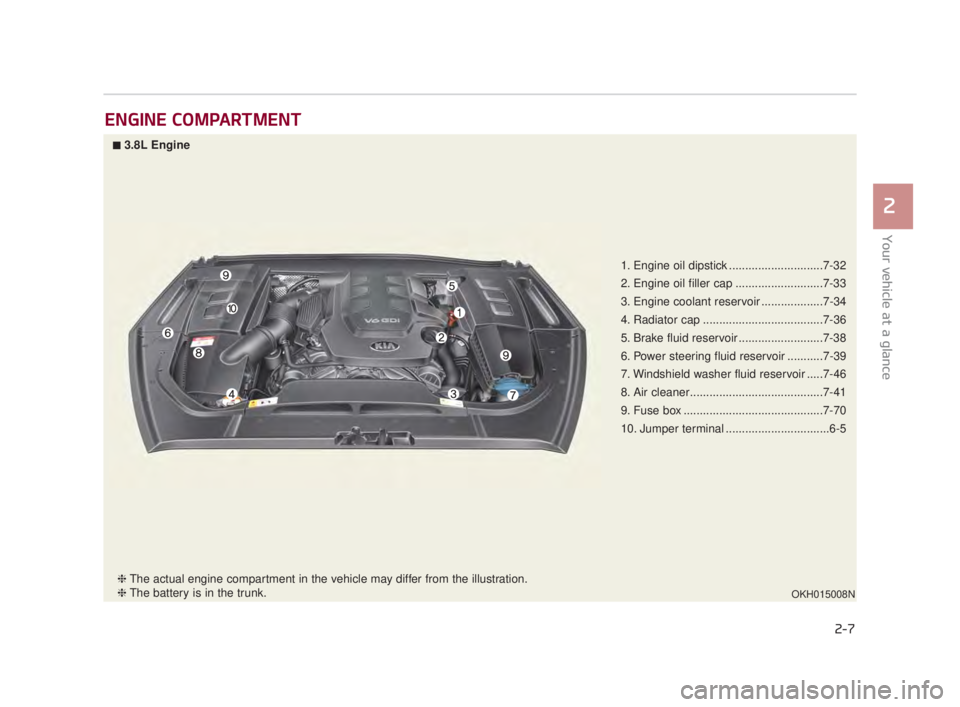
ENGINE COMPARTMENT
Your vehicle at a glance
2
2-7
1. Engine oil dipstick .............................7-32
2. Engine oil filler cap ...........................7-33
3. Engine coolant reservoir ...................7-34
4. Radiator cap .....................................7-36
5. Brake fluid reservoir ..........................7-38
6. Power steering fluid reservoir ...........7-39
7. Windshield washer fluid reservoir .....7-46
8. Air cleaner.........................................7-41
9. Fuse box ...........................................7-70
10. Jumper terminal ................................6-5
OKH015008N
❈The actual engine compartment in the vehicle may differ from the illustration.
❈ The battery is in the trunk.
■3.8L Engine
KH USA 2:2016 4/21/2017 1:33 PM Page 7
Page 18 of 544
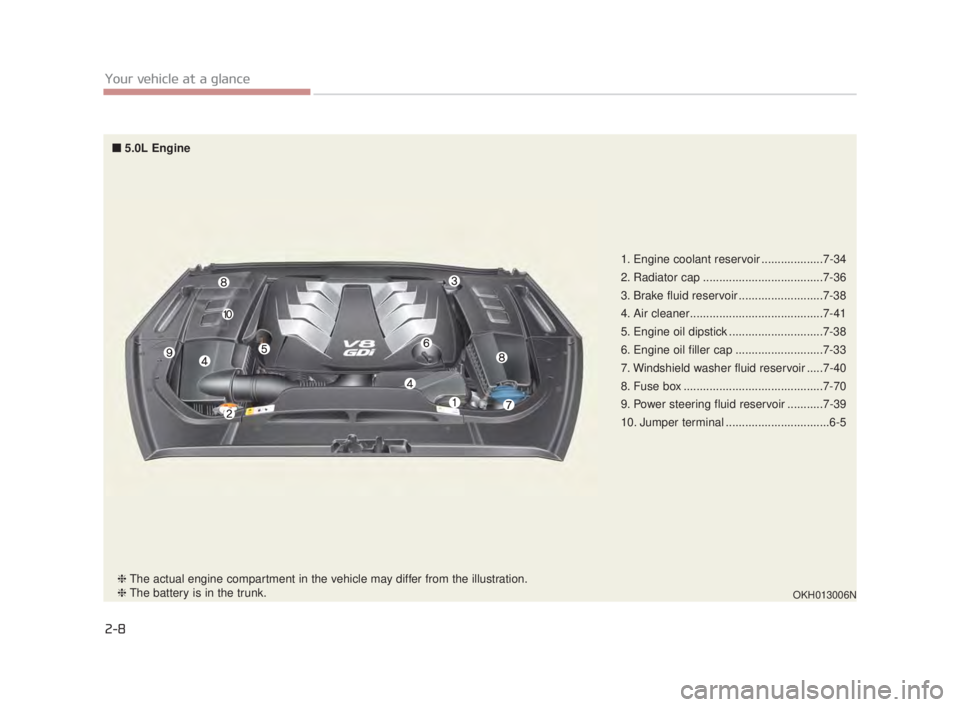
2-8
Your vehicle at a glance
OKH013006N
1. Engine coolant reservoir ...................7-34
2. Radiator cap .....................................7-36
3. Brake fluid reservoir ..........................7-38
4. Air cleaner.........................................7-41
5. Engine oil dipstick .............................7-38
6. Engine oil filler cap ...........................7-33
7. Windshield washer fluid reservoir .....7-40
8. Fuse box ...........................................7-70
9. Power steering fluid reservoir ...........7-39
10. Jumper terminal ................................6-5
❈The actual engine compartment in the vehicle may differ from the illustration.
❈ The battery is in the trunk.
■
5.0L Engine
KH USA 2:2016 4/21/2017 1:33 PM Page 8
Page 26 of 544

3-8
Seat and safety features of your vehicle
Driver position memory system
A driver position memory system is
provided to store and recall the driv-
er seat, outside rearview mirror,
HUD* (Head-Up Display), bright
ness of the instrument cluster illumi-
nation and steering wheel positions
with a simple button operation.
* : if equipped
By saving the desired positions into
the system memory, different drivers
can reposition the driver seat, out-
side rearview mirror and steering
wheel based upon their driving pref-
erence. If the battery is disconnect-
ed, the position memory will be lost
and the driving positions should be
restored in the system.Storing positions into memoryusing the buttons on the door
Storing driver’s seat positions
1.Check that the shift lever is in P (Park) and the Engine Start/Stop
Button is in the ON position.
2.Adjust the driver seat, outside rearview mirror, HUD* (Head-up
Display), bright ness of the instru-
ment cluster illumination and steer-
ing wheel to positions comfortable
for the driver.
3.Press the SET button on the control panel. The system will beep once.
4.Press one of the memory buttons (1 or 2) within 5 seconds after
pressing the SET button. The sys-
tem will beep twice when memory
has been successfully stored.
* : if equipped
OKH043039NDriver position memory
system
Never attempt to operate the
driver position memory system
while the vehicle is moving.
This could result in loss of con-
trol, and an accident causing
death, serious injury, or proper-
ty damage.
WARNING
KH USA 3:2018 4/18/2017 9:34 AM Page 8
Page 32 of 544
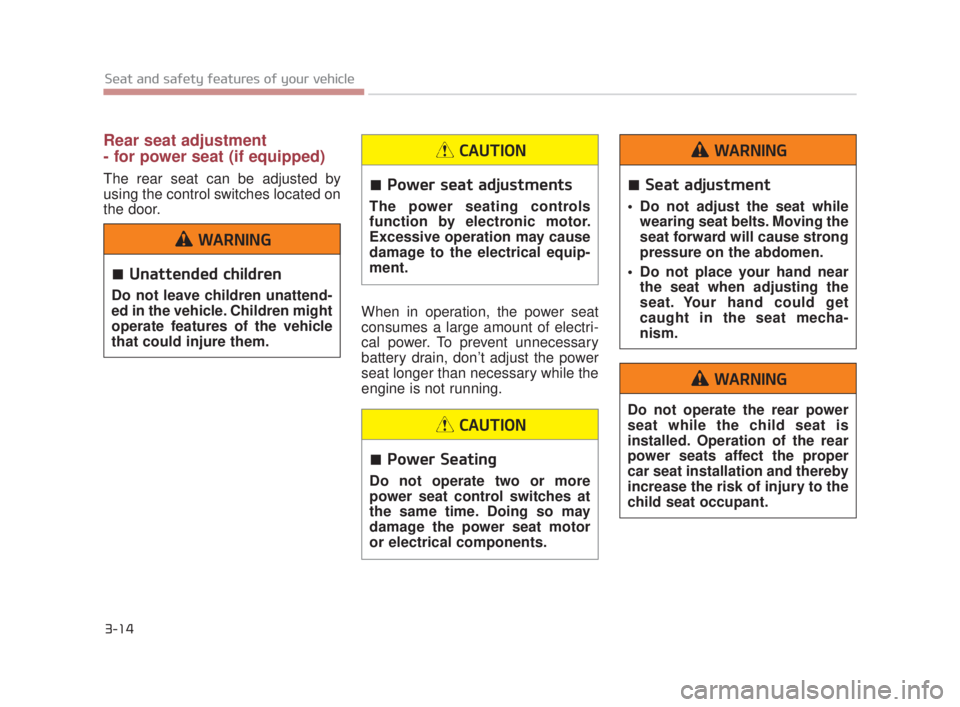
3-14
Seat and safety features of your vehicle
Rear seat adjustment
- for power seat (if equipped)
The rear seat can be adjusted by
using the control switches located on
the door.When in operation, the power seat
consumes a large amount of electri-
cal power. To prevent unnecessary
battery drain, don’t adjust the power
seat longer than necessary while the
engine is not running.Seat adjustment
Do not adjust the seat whilewearing seat belts. Moving the
seat forward will cause strong
pressure on the abdomen.
Do not place your hand near the seat when adjusting the
seat. Your hand could get
caught in the seat mecha-
nism.
WARNING
Do not operate the rear power
seat while the child seat is
installed. Operation of the rear
power seats affect the proper
car seat installation and thereby
increase the risk of injury to the
child seat occupant.
WARNING
Power seat adjustments
The power seating controls
function by electronic motor.
Excessive operation may cause
damage to the electrical equip-
ment.
CAUTION
Power Seating
Do not operate two or more
power seat control switches at
the same time. Doing so may
damage the power seat motor
or electrical components.
CAUTION
Unattended children
Do not leave children unattend-
ed in the vehicle. Children might
operate features of the vehicle
that could injure them.
WARNING
KH USA 3:2018 4/18/2017 9:34 AM Page 14
Page 39 of 544
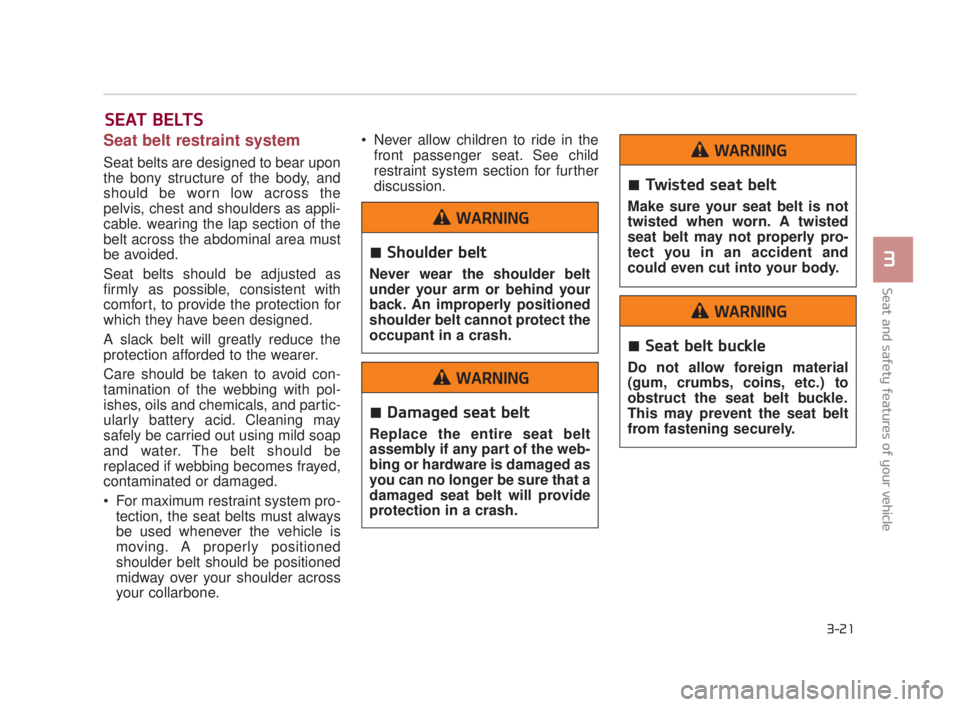
Seat and safety features of your vehicle
3
3-21
Seat belt restraint system
Seat belts are designed to bear upon
the bony structure of the body, and
should be worn low across the
pelvis, chest and shoulders as appli-
cable. wearing the lap section of the
belt across the abdominal area must
be avoided.
Seat belts should be adjusted as
firmly as possible, consistent with
comfort, to provide the protection for
which they have been designed.
A slack belt will greatly reduce the
protection afforded to the wearer.
Care should be taken to avoid con-
tamination of the webbing with pol-
ishes, oils and chemicals, and partic-
ularly battery acid. Cleaning may
safely be carried out using mild soap
and water. The belt should be
replaced if webbing becomes frayed,
contaminated or damaged.
For maximum restraint system pro-tection, the seat belts must always
be used whenever the vehicle is
moving. A properly positioned
shoulder belt should be positioned
midway over your shoulder across
your collarbone. Never allow children to ride in the
front passenger seat. See child
restraint system section for further
discussion.
SEAT BELTS
Shoulder belt
Never wear the shoulder belt
under your arm or behind your
back. An improperly positioned
shoulder belt cannot protect the
occupant in a crash.
WARNING
Damaged seat belt
Replace the entire seat belt
assembly if any part of the web-
bing or hardware is damaged as
you can no longer be sure that a
damaged seat belt will provide
protection in a crash.
WARNING
Twisted seat belt
Make sure your seat belt is not
twisted when worn. A twisted
seat belt may not properly pro-
tect you in an accident and
could even cut into your body.
WARNING
Seat belt buckle
Do not allow foreign material
(gum, crumbs, coins, etc.) to
obstruct the seat belt buckle.
This may prevent the seat belt
from fastening securely.
WARNING
KH USA 3:2018 4/18/2017 9:34 AM Page 21
Page 64 of 544
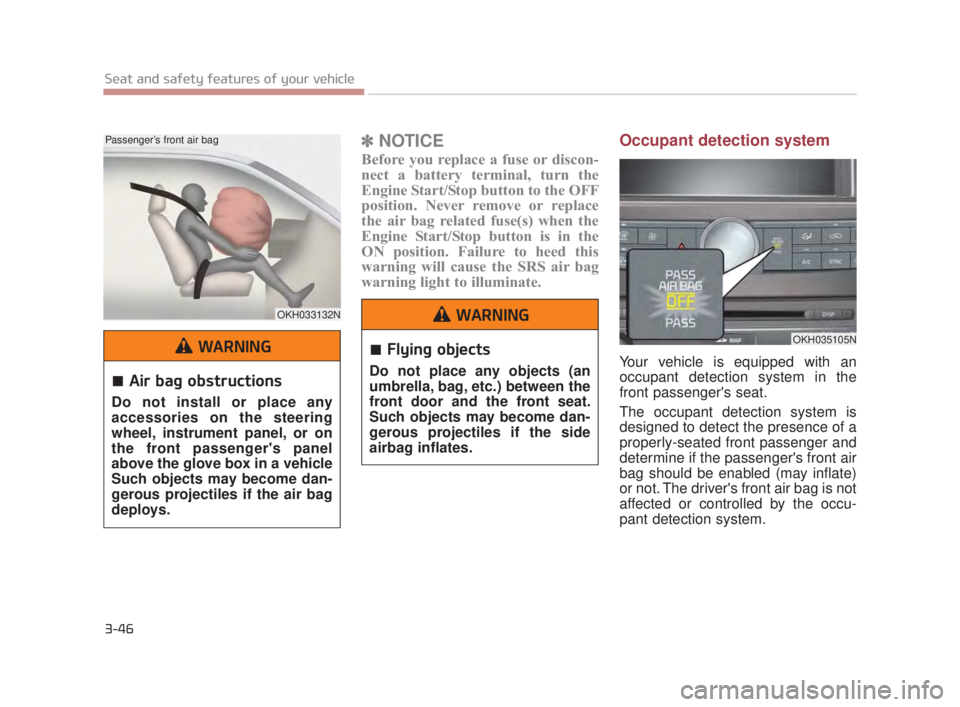
3-46
Seat and safety features of your vehicle
✽NOTICE
Before you replace a fuse or discon-
nect a battery terminal, turn the
Engine Start/Stop button to the OFF
position. Never remove or replace
the air bag related fuse(s) when the
Engine Start/Stop button is in the
ON position. Failure to heed this
warning will cause the SRS air bag
warning light to illuminate.
Occupant detection system
Your vehicle is equipped with an
occupant detection system in the
front passenger's seat.
The occupant detection system is
designed to detect the presence of a
properly-seated front passenger and
determine if the passenger's front air
bag should be enabled (may inflate)
or not. The driver's front air bag is not
affected or controlled by the occu-
pant detection system.
OKH033132N
Passenger’s front air bag
OKH035105N
Air bag obstructions
Do not install or place any
accessories on the steering
wheel, instrument panel, or on
the front passenger's panel
above the glove box in a vehicle
Such objects may become dan-
gerous projectiles if the air bag
deploys.
WARNINGFlying objects
Do not place any objects (an
umbrella, bag, etc.) between the
front door and the front seat.
Such objects may become dan-
gerous projectiles if the side
airbag inflates.
WARNING
KH USA 3:2018 4/18/2017 9:36 AM Page 46
Page 89 of 544
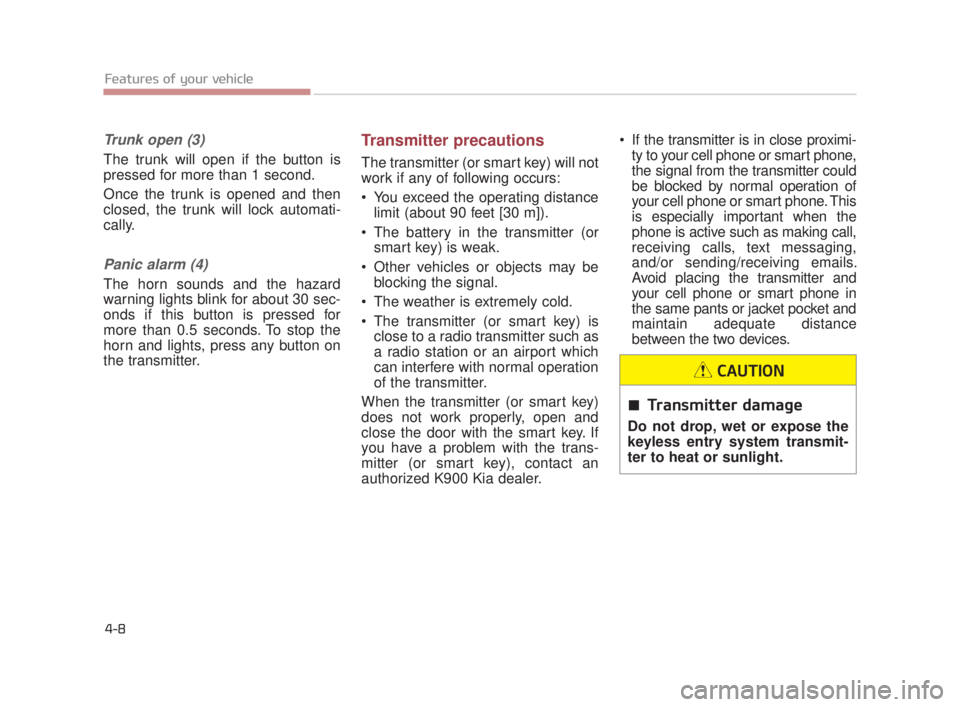
Features of your vehicle
4-8
Trunk open (3)
The trunk will open if the button is
pressed for more than 1 second.
Once the trunk is opened and then
closed, the trunk will lock automati-
cally.
Panic alarm (4)
The horn sounds and the hazard
warning lights blink for about 30 sec-
onds if this button is pressed for
more than 0.5 seconds. To stop the
horn and lights, press any button on
the transmitter.
Transmitter precautions
The transmitter (or smart key) will not
work if any of following occurs:
You exceed the operating distancelimit (about 90 feet [30 m]).
The battery in the transmitter (or smart key) is weak.
Other vehicles or objects may be blocking the signal.
The weather is extremely cold.
The transmitter (or smart key) is close to a radio transmitter such as
a radio station or an airport which
can interfere with normal operation
of the transmitter.
When the transmitter (or smart key)
does not work properly, open and
close the door with the smart key. If
you have a problem with the trans-
mitter (or smart key), contact an
authorized K900 Kia dealer. If the transmitter is in close proximi-
ty to your cell phone or smart phone,
the signal from the transmitter could
be blocked by normal operation of
your cell phone or smart phone. This
is especially important when the
phone is active such as making call,
receiving calls, text messaging,
and/or sending/receiving emails.
Avoid placing the transmitter and
your cell phone or smart phone in
the same pants or jacket pocket and
maintain adequate distance
between the two devices.
Transmitter damage
Do not drop, wet or expose the
keyless entry system transmit-
ter to heat or sunlight.
CAUTION
KH USA 4:2018 4/18/2017 5:55 PM Page 8